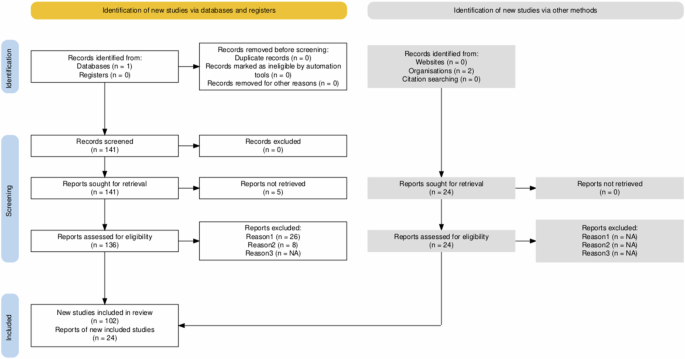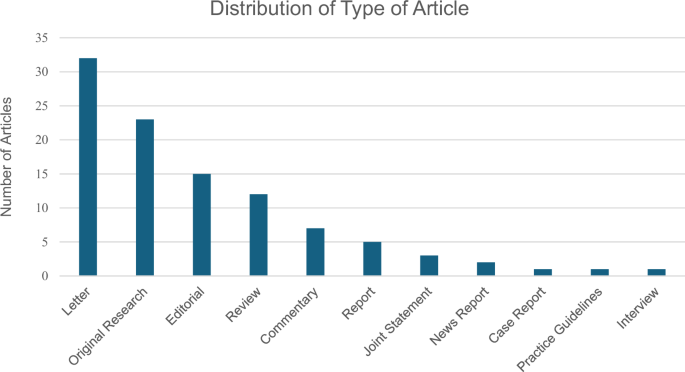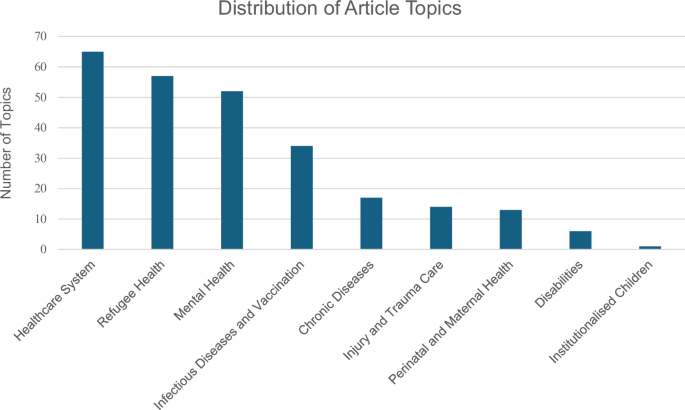The scoping review included a comprehensive analysis of 102 articles, covering a broad spectrum of topics related to the impact of the Russo-Ukrainian War on paediatric health. The studies were sourced from PubMed and included a mix of letters, original research, reviews, editorials, commentaries, and case reports. The articles were published between February 24, 2022, and September 7, 2023, reflecting the immediate and ongoing effects of the conflict on child health in Ukraine. The final articles that were used in this article are listed together with the identified type of article, main and subtopics in Supplementary Data.
Types of studies
The most common type of article was letters, accounting for approximately 30% of the total articles included. These were primarily focused on the immediate challenges faced by healthcare providers and the broader public health implications of the conflict. Original research articles constituted about 25% of the studies, providing empirical data on specific health outcomes such as mental health impacts and the spread of infectious diseases. Reviews made up about 10% of the total, offering synthesised insights into broader topics such as chronic disease management and refugee health. The remaining articles included commentaries, case reports, and joint statements, which provided expert opinions, case analyses, and collaborative insights from international health bodies. The distribution of types of articles is visually represented in Fig. 2.
Geographical and thematic focus
The articles predominantly focused on the impact of the war within Ukraine, particularly in regions most affected by the conflict, such as the eastern territories. However, there was also significant attention given to the health challenges faced by Ukrainian refugees in host countries, including neighbouring nations like Poland, Germany, and Romania.
Thematically, the articles covered a wide range of topics, and the distribution of the articles’ topics is visually represented in Fig. 3.
Key findings
The review identified a consistent theme of severe disruption in healthcare access, with many studies documenting the impact of the conflict on both physical and mental health services for children. The included studies provided a multi-layered view of the toll that the Russo-Ukrainian War has taken on paediatric health, while also identifying key areas where further research and policy intervention are needed. The following sections provide a detailed breakdown of the findings, highlighting both the immediate and long-term impacts on paediatric healthcare in Ukraine.
Disrupted access to essential and healthcare services
The invasion of Ukraine in February of 2022 and subsequent warfare have impacted access to basic services essential for survival and to the healthcare system at large19,20,21,22,23,24,25,26,27,28,29,30,31,32,33,34,35,36,37,38,39,40,41,42,43,44,45,46,47,48,49,50,51,52,53,54,55,56,57,58,59,60,61,62,63,64,65,66,67,68,69,70,71,72,73,74,75,76,77,78,79,80,81,82. Disruptions in electricity have hindered food storage and heating, leading to increased food prices and compromised living conditions19,26,28,29. In the Mariupol Oncological Dispensary, generators intended for upholding advanced treatments were being used sparingly to prioritise cooking and feeding patients and staff over medical uses31. However, this situation was not representative of all affected regions in Ukraine.
The Russian invasion has severely disrupted access to healthcare services across Ukraine22,29,83,84,85,86,87. Emergency medical services face blockades and shelling, hindering the transfer of critically ill patients, including children22,29. Russian forces have denied ambulances access to occupied cities, further exacerbating the crisis22.
Primary healthcare services such as vaccinations and routine check-ups have largely been suspended due to a reallocation of resources towards treating war-related injuries31,88. Despite these challenges, a pilot programme has been initiated to expand the newborn genetic screening programme from covering four to 21 disorders, including conditions such as spinal muscular atrophy80.
The war has also affected healthcare workers19,20,32,33,63,72,77,78. The invasion has led to a shortage of doctors, with many forced to relocate due to safety concerns19. Healthcare workers themselves experience heightened stress and anxiety, further impacting the workforce19. Women make up 83% of the country’s health workforce but also compose the majority of migrants and internally displaced people21,37. Medical education has also been disrupted, with students leaving the country or joining the military24. In occupied regions, the departure of essential personnel like oncologists and radiation safety officers has compromised equipment control and safety31.
Disruptions in traditional communication channels due to power outages and mobile limitations have prompted doctors to adopt telemedicine and to use messaging platforms for patient communication19,28,31 However, critics warn that virtual healthcare systems make them increasingly more vulnerable to cyberattacks29.
Impact on specific health issues
At the heart of this conflict’s impact on paediatric health are specific challenges that exacerbate an already dire situation. These include difficulties in managing direct injuries, chronic diseases, disrupted maternal and perinatal health services, and an increase in infectious diseases due to vaccine programme interruptions. A breakdown of these key health issues is provided below.
Injury and trauma care
Children have repeatedly been exposed to what appears to be deliberate bombings of schools, hospitals, and playgrounds36,89. Reports also indicate illegal deportation and hostage-taking of children from Ukraine to Russia or Russian-held territories36,89.
The war has inflicted direct injuries on children through explosive weapons and gunfire22,25,28,34,35,36,70,81,82,89,90,91,92,93. Children suffer severe burns, head and neck trauma, and penetrating injuries, which require specialised medical care and disproportionate levels of health services81,91.
The direct effects of the war on children’s health are also illustrated by case reports such as that of a 16-year-old boy who was shot at close range to the back of the neck and treated at National Pirogov Memorial Medical University, Vinnytsya, Ukraine34. The bullet injured his spinal cord, resulting in left upper limb paralysis and loss of sensation.
Gunshot trauma in children requires immediate evaluation and surgical intervention to improve postoperative recovery and physical therapy outcomes. Optimal interventions require access to ultrasound, computed tomography, and magnetic resonance imaging, alongside exploratory surgery34. All gunshot and shrapnel wounds are also considered conditionally contaminated and require broad-spectrum antibiotic therapy.
Traumatic experiences may lead to both physical and long-term psychological trauma, with children suffering from PTSD, anxiety, depression, and other mental health issues21,28,45,60,63,64,89,90,91,93,94,95. There is little documentation of physical rehabilitation needs that the war produces apart from general guidelines emphasising that rehabilitation should be active, long and continuous34.
Perinatal and maternal health
The war has substantially affected perinatal and maternal health20,21,23,30,37,38,39,40,79,80,96,97,98. Pregnant women face limited access to maternal healthcare due to infrastructure damage and restricted medical treatment availability40,85,88,99, which increases the risk of obstetric complications as well as maternal and neonatal mortality21,40,83,88. Reports from the World Health Organisation underline the limited data pertaining to maternal and newborn health100.
Perinatal centres in Ukraine have operated under extreme conditions, with deliveries and caesarean sections performed in bomb shelters during airstrikes37,100. Several hospitals have been repurposed from providing essential services and primary healthcare to supporting and providing care for conflict-related trauma, leading to disruptions in basic and routine healthcare services, including maternal and child health88. This shift in priorities reflects the overwhelming demands placed on healthcare systems during the conflict, compromising routine but essential care services. Higher prevalence of preterm babies has been noted in conflict zones60,100. This is particularly concerning, considering specialised care required for premature and at-risk infants is likely unavailable in these regions100. Negative experiences among pregnant women also stem from fear, uncertainty, and lack of support during the war38.
Millions of Ukrainian children under five and pregnant/breastfeeding mothers urgently need nutritional aid, especially in war-torn eastern regions101. Distributing breast milk substitutes is crucial since breastfeeding rates are low88,101,102. Breast milk has sometimes been the only available source of nutrition in shelters37. Certain perinatal centres have managed to secure breast milk for critically ill children through limited donor programmes37. Internet resources have been established to provide information on breastfeeding, and new guidelines have been published regarding infant and young child feeding following a nuclear emergency37.
The war has also shed light on the complexities of surrogacy in Ukraine, where commercial surrogacy has been legal since 200239,79. The armed conflict has exposed vulnerabilities within the system, leaving children born through surrogacy stranded and surrogate mothers in Ukraine facing legal issues39.
Chronic diseases
It is well documented that children with chronic conditions have been impacted by this war24,27,30,33,42,67,68,70,73,80,92,98,103,104,105,106,107. Children with chronic illnesses face difficulties managing their conditions due to limited access to medication and essential equipment19,107,108,109. The war has led to fewer patient visits and reduced availability of care19. Additionally, conflict may have led to preventable complications from delayed diagnosis and treatment19,83.
Cancer
Wars consequence on cancer care is also highly apparent24,30,31,43,44,68,73,74,108,110,111. Cancer poses a significant challenge, with hundreds of children at risk of premature death due to treatment interruptions, stress, and increased infection risk112. Cancer facilities have closed or reduced the number of treatments provided due to power shortages, forcing centres in western Ukraine to accommodate twice the normal patient-load31,113. This increase in patient load in western Ukraine leaves hospitals vulnerable, with little capacity for handling any additional influx of patients or unforeseen crises112.
Institutionalised children with disabilities
Prior to the conflict, Ukraine had one of the highest rates of institutionalised children, over half with disabilities58. Children with disabilities have been affected by the invasion24,25,29,58,64,68 and represent a group particularly at risk of exclusion from social protection and neglect, abandonment and death24,55. It is imperative for social care institutions and public health to ensure that these individuals are recognised and have access to professional care24.
Infectious diseases and vaccination challenges
The war has impacted the spread of infectious diseases and contributed to even lower vaccination rates24,29,30,41,44,45,46,47,48,49,50,51,52,53,57,67,68,71,76,90,92,96,97,98,105,114,115,116,117,118,119,120,121,122. Ukraine already had a high prevalence of infectious diseases such as HIV and Tuberculosis prior to the invasion in 2022, compared to other European countries46,114. The war has worsened access to diagnostics and treatment, while crowded conditions in displacement settings increase the risk of spreading these diseases46,83,114,123.
Ukraine’s vaccination rates are among the lowest in Europe, with vaccination efforts hampered as a consequence of war52,88,92,113,114. Vaccine hesitancy remains high, especially in rural areas, contributing to the challenges of maintaining immunisation programmes during conflict76,92. Disrupted national vaccination programmes have led to low immunisation rates for diseases such as polio, measles, and COVID-1952,88,92,96,98,113,114,122,123,124, posing significant risks not only within Ukraine but also in host countries due to the potential of outbreaks of vaccine-preventable diseases among refugee populations124.
The rise of antimicrobial resistance is a particular fear, with multi-resistant bacteria posing a threat to both children and those with war injuries103,119. The problem is exacerbated by the overuse of broad-spectrum antibiotics in conflict zones where hygiene is poor and deep, contaminated wounds are common125,126,127. Laboratory assessments in Ukraine identified multiple challenges, including inadequate quantities of automated microbiology equipment, suboptimal laboratory quality, and limitations in information management systems127. The mass exodus of people raises concerns about the potential spread of resistant bacterial strains, highlighting the need for strict antibiotic surveillance46,114,127.
Mental health
The acute stress of the conflict has exacerbated mental health effects of the COVID-19 pandemic, straining an already resource-limited system27,32,55,58,83,124,128,129,130. Many articles warn about the inevitable effects of the war on paediatric mental health23,25,26,27,29,30,32,35,37,38,43,54,55,56,57,58,59,60,61,62,63,64,66,67,68,72,75,77,78,82,89,90,91,92,93,94,95,96,98,105,121,128,129,131,132,133,134,135,136,137,138,139.
While research on Ukrainian children’s mental health is partial, surveys reveal significant issues among refugees, including self-mutilation, intoxications, and insomnia58,92. A study estimated that 20% of Ukrainian children have endured at least two adverse life experiences, such as physical or sexual abuse, domestic violence, or household issues such as substance abuse and criminality96,132.
Specialists warn that untreated psychological trauma can have long-lasting effects, potentially impacting future generations, and there is an urgent need for active screening and trauma-focused interventions55,60,77,93,132,134,138,140. However, efforts are hindered by a lack of trained specialists within paediatric psychiatry and appropriate assessment tools for younger children56,63,78,131,136,139.
Challenges for displaced children and receiving countries
The invasion has resulted in significant internal and external displacement of people21,24,25,26,27,41,45,46,51,52,53,54,57,59,61,63,64,65,66,67,68,69,71,73,74,89,92,94,95,96,97,98,103,105,107,108,110,111,114,115,116,117,119,120,121,122,128,129,131,132,133,134,135,136,137,138. The displacement has strained evacuation centres with overcrowding, inadequate heating, and increased risk of communicable diseases21,26,83,120,121. Not only are paediatricians limited in these settings24, concerns about sexual and gender-based violence have emerged within these displacement settings as well67,83,101,124.
Neighbouring countries face significant challenges in providing healthcare for the sudden influx of refugees, mainly consisting of women and children67. International organisations and NGOs have mobilised additional staff to address these needs66,67. However, challenges persist, including coordination issues, inadequate healthcare system readiness, and limited cross-border collaboration67. Action is necessary to adapt guidelines, establish safe reception centres, improve migration governance, and provide essential tools and training for healthcare workers to meet evolving needs67. There is a proposal for coordinated military-civilian transfer of severe paediatric war zone trauma victims to neighbouring countries to improve patient outcomes92.
Host countries face logistical challenges in organising assessments and treatment plans for disabled and cancer-diagnosed children65,68. Special attention must be given to children with complex needs to ensure their access to specialist healthcare during resettlement programmes92. Healthcare professionals experience a lack of guidelines, language barriers, and limited medical history upon refugees’ arrival26,65,92. Converting prescriptions to national equivalents and addressing differences in immunisation schedules pose additional challenges105. Navigating foreign healthcare systems, compounded by language barriers, further impedes access to care61. Addressing these barriers is essential for the well-being of Ukrainian refugees in host nations.


